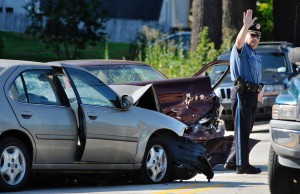
This holiday season is expected to see an uptick in traffic fatalities and injuries, according to the National Safety Council.
Predictions call for a record number of travelers this holiday season and with more people on the roads, there are bound to be more accidents. Officials expect traffic deaths and injuries will be their highest levels since 2009.
The National Safety Council expects 307 people will be killed and 37,200 seriously injured in traffic crashes during the three-day Christmas holiday period. The group also estimates 346 will be killed and 41,900 seriously injured during the three-day New Year’s holiday period.
More than 100 million people are expected to travel for the holidays with more than 90% of those expected to be climbing behind the wheel to get to their holiday destinations.
One simple change in behavior – wearing a seatbelt – could save an estimated total of 405 lives during these two holidays.
“Too many celebrations are marred by tragedies during the holiday season,” said Deborah A.P. Hersman, president and CEO of the National Safety Council. “When you are traveling, remember that you are your car’s most important safety feature. Getting to zero deaths on our roadways requires each of us to be safer behind the wheel.”
(Holiday travel records expected to fall due to cheap gas. For more, Click Here.)
There are some simple things the group recommends drivers do to improve to safety:
- Wear a seat belt on every trip
- Designate an alcohol and drug-free driver or arrange alternate transportation
- Get plenty of sleep and take regular breaks to avoid fatigue
- Never use a cell phone behind the wheel, even hands free
- Do not allow teens to drive with their friends. A single young passenger can increase a teen driver’s fatal crash risk 44%
- Learn about your vehicle’s safety systems and how to use them
The increase in holiday travel this year is being driven by continued improvement in the labor market, rising incomes and low prices, including gas prices that remain well below last year’s levels. This is helping boost Americans’ disposable income, but some consumers continue to remain cautious about their finances as they head into the holiday season.
“Rising incomes and low gas prices are helping to fill stockings this year, and more people than ever will choose to spend those savings on travel this year,” said Marshall Doney, AAA president and CEO.
The national average price for a gallon of gasoline remains poised to fall below the $2 per gallon benchmark by Christmas. Today’s national average is $2.01, 55 cents less than last year. AAA expects most U.S. drivers will pay the lowest gas prices on New Year’s Day since 2009.
The two holiday periods fall at the end of a particularly deadly year on the roads. Preliminary NSC estimates indicate traffic deaths are up significantly through the first 10 months of 2015 compared with the same time period in 2014.
(Click Here for details about which states have the worst drivers.)
Official numbers aren’t available through October, traffic deaths spiked by 8% during the first half of the year, according to a new federal report, reversing a decade-long downward trend.
The sharp surge comes at a time when safety-related automotive recalls have also grown rapidly. A total of 64 million vehicles were affected in 2014, double the previous record set in 2004, and the industry could set yet another all-time high this year.
But Rosekind noted that 94% of all crashes are blamed on driver error, saying that, “It is important for Americans to know that human behaviors are by far the largest cause of fatalities.”
NHTSA has put an emphasis on distracted driving, a problem linked, but not limited, to texting and calling while driving. All told, the agency has blamed the problem for 10% of the 32,675 U.S. traffic deaths last year, but Rosekind suggested it may make up an even larger total but is difficult to confirm.
U.S. highway fatalities peaked in the 1970s then fell 40% over the following four decades. But the decline had been slowing in recent years, the total drop last year just 0.1%. But it also marked a record low of just 1.07 deaths per million vehicle miles driven. That figure rose 4% during the first half of 2015.
(To see more about why accidents are on the rise after a decade of declines, Click Here.)
This year has seen the reversal of a significant trend: after a decade in which Americans drove an average 25% fewer miles each year, other studies have shown motorists are beginning to clock more miles again. According to the Federal Highway Administration, U.S. drivers close 1.54 trillion miles during the first half of 2015, a 3.5% year-over-year increase.
